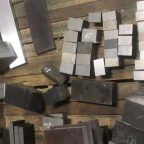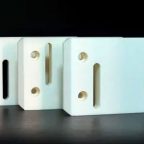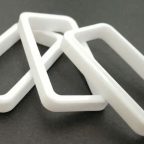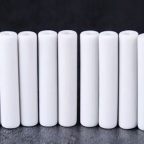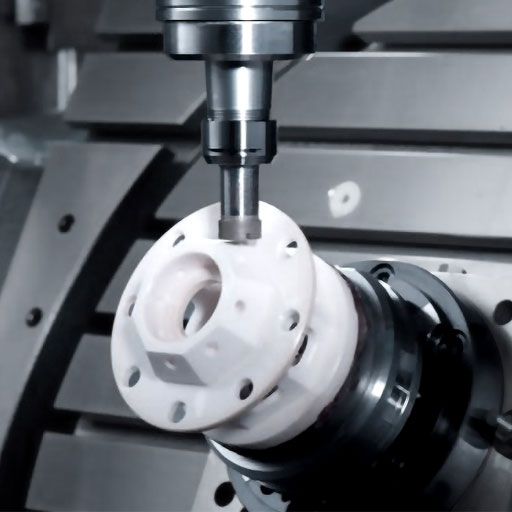Special ceramics, also known as fine ceramics, are classified according to their application functions and can be roughly divided into two categories: high-strength, high-temperature-resistant and composite structural ceramics and electrical and electronic functional ceramics. Inorganic materials with special formula are added to the ceramic blanks, which are sintered at a high temperature of about 1360 degrees to obtain stable and reliable anti-static properties and become a new type of special ceramics, which usually have one or more functions, such as: electricity, magnetism, Optical, thermal, acoustic, chemical, biological and other functions; and coupling functions, such as piezoelectric, pyroelectric, electro-optical, acousto-optical, magneto-optical and other functions. At present, special ceramics have been widely used in all walks of life. Let’s subdivide the classification and main uses of special ceramics:
(1) Nano ceramics:
It refers to a ceramic material whose grain size, grain boundary width, second phase distribution, and defect size are all below 100 nm and have inherent characteristics of nanomaterials. It must be pointed out that even if nano-powder is used, the green body tends to experience rapid crystal growth and even secondary recrystallization during the sintering process.
Inherent properties, it can not be called nano-ceramics. On the other hand, many recent reports show that once nano-ceramics are obtained, it is expected to overcome the brittleness of ceramic materials, and have significant superplasticity and high strength.
(2) Ceramic separation membrane:
It is a solid membrane, mainly composed of two parts, namely membrane support and porous membrane. The support body is widely used alumina ceramics with high aluminum content. The porous membrane is mainly composed of AL2O3, ZrO2, TiO2 and SiO2. Generally, the pore size of separation membrane is: 2~50nm, sometimes reaching the micron level, and its varieties and specifications are becoming more and more diversified. Separation membranes usually have good chemical stability, acid resistance, alkali resistance, organic solvent resistance, high mechanical strength, good wear resistance, backwashing; strong antimicrobial ability; high temperature resistance; narrow pore size distribution, high separation efficiency .
At present, many products have been applied in wastewater treatment, fruit juice production, solid-liquid separation, etc., and are expected to be widely used in many fields such as environmental engineering, petrochemical engineering, biological engineering, metallurgical industry and nano-powder preparation, and the market prospect is quite good. Significant social and economic benefits. At present, ceramic membrane separation technology is developing rapidly, and it is developing in the direction of mesoporous membrane and gas-gas separation membrane.
(3) Biomimetic composite ceramics:
In order to overcome the brittleness of ceramic materials and improve their toughness, many scientists at home and abroad have obtained inspiration from the analysis of the structural characteristics of natural biological materials such as bamboo and shells, so as to further improve the material design and preparation technology of structural ceramics. Research has been carried out in many aspects. Sure enough, some biomimetic composite ceramics were obtained. The main technical measures are fiber, whisker reinforcement, particle dispersion, self-reinforcing (in-situ growth), multi-phase reinforcement and surface modification.
For example, the strength of YTZP ceramic material at room temperature has reached more than 2000mpa, and the KIC has exceeded 15, reaching a strength comparable to some metal materials. For another example, SiC ceramics form a Si3N4 surface layer through N2, which significantly improves the strength and fracture toughness. In short, the high strength, high wear resistance and other characteristics of multiphase special ceramic materials have achieved remarkable results in the application of high-tech fields, and have become one of the research hotspots of structural ceramics.
(4) Substrate material
At present, Al2O3 ceramics are mainly used as IC substrate materials at home and abroad. However, with the development of electronic components in the direction of high performance, high density, high power, miniaturization and low cost, it is urgent to use ceramic substrates with high thermal conductivity, which is theoretically the most suitable Candidate materials are diamond (C), cubic boron nitride (BN), beryllium oxide (BeO), silicon carbide (SiC), and aluminum nitride (AlN). Since the thermal conductivity of AlN is as high as 250W·m-1·K-1, although it is slightly lower than that of SiC and BeO, it is slightly higher than Al2O3 by 8~10 times. Its volume resistivity, breakdown strength, dielectric loss and other electrical properties can be compared with It is comparable to Al2O3 porcelain, and has a low dielectric constant and high mechanical strength.
The thermal expansion coefficient is 4.4ppm/℃, which is close to Si and can be used for multi-layer wiring. It can be considered as one of the best candidate materials. At present, Toshiba, Toshiba and some companies in the United States have begun to apply on a considerable scale, and the total annual output of AlN ceramics has exceeded 1,000 tons.
At present, the china AlN substrate is still in its infancy, and the main basic indicators of thermal conductivity are mostly 130~180 W·m-1·K-1. The performance of the scientific and technological products of some research units has approached the international level, but the problems of high performance, mass production, product consistency and low cost need to be further solved.
(5) Resistor base material
Resistors are the basic components of circuits, which are widely used and in great demand. Generally, carbon film and metal film resistors have low technical content, low product value, and small profits for a single product. Due to factors such as raw materials, labor, energy, etc., there are certain sales in the international market, but the china market has fierce price competition.
On the other hand, high-performance, ultra-small, high-power, high-stability new chip, non-inductive resistors have a broad market at home and abroad, and have good social and economic benefits. Due to technical and equipment problems, my country is still in its infancy.
(6) Capacitor ceramic dielectric material
In recent years, the main development trend is to seek ceramic capacitors with large capacity, small size, high reliability and low price. Compared with traditional BaTiO3-based dielectric materials, composite perovskite-type materials have emerged in order to increase the dielectric constant and improve performance. It is worth pointing out the emergence of grain boundary layer capacitors (GBLCs) developed based on the principle of semiconductor pn junctions, whose apparent dielectric constants are several times to dozens of times higher than those of conventional ceramic dielectric capacitors.
Grain boundary layer capacitors based on SrTiO3 have the advantages of high dielectric constant, low dielectric loss, low temperature coefficient and high dispersion frequency, and are one of the most promising ceramic materials. At present, a few china manufacturers have entered mass production, but there is still a certain gap in terms of high performance and high pass rate.
It is believed that the emergence of grain boundary layer multilayer capacitor (GBMLC) ceramics will make a major breakthrough in the direction of miniaturization of capacitors.
(7) Piezoelectric ceramic materials
Piezoelectric ceramics are important functional materials to realize the mutual conversion of mechanical energy and electrical energy, and are widely used in many fields such as audio equipment, sensors, alarms, ultrasonic cleaning, medical diagnosis and communication. Generally, the piezoelectric ceramic material is lead zirconate titanate (PZT) series, and the lead oxide content in some ceramic materials is as high as about 60~70%. Due to the dust generated during the production process and the lead volatilization during the sintering process, this not only affects the process and The stability of product quality brings many problems, and also brings harm to the ecological environment and human health. It has become a very urgent task to study new lead-free piezoelectric ceramics to reduce environmental pollution.
In 1961, former Soviet Union scholars Smolensky and others discovered that bismuth sodium titanate (Bi1/2Na1/2) TiO3, or BNT for short, is a perovskite (ABO3) ferroelectric. Its Curie point is 320°C. The difficulty of polarization limited its practical application. Until the end of the 1980s, Japanese scholars Takenaka and others used Ba++ to change the A position of Bi1/2Na1/2, and the BNT-BaTiO3 series, that is, BNBT series piezoelectric ceramics, appeared, which solved the problem. BNT is difficult to polarize; a new system with high frequency constant, small dielectric constant and large anisotropy is obtained. It is expected to be applied in the field of ultrasound. In recent years, some scholars at home and abroad have carried out modification research based on BNBT system, and some progress has been made. However, it is necessary to seek a new lead-free high-performance piezoelectric ceramic system to replace the traditional PZT system. No easy task, and much work to be done.
(8) Microwave ceramic dielectric materials
Since Masse et al. first proposed the use of barium tetratitanate (BaTi4O9) as a microwave ceramic dielectric material in 1971, with the continuous development of modern communication technology, especially the development of mobile communication towards high reliability and small size, the requirements for materials are getting higher and higher. Come higher. In order to meet the requirements of different uses, there are many types of microwave ceramic dielectric materials. Mainly include: TiO2; 2MgO· SiO2; Al2O3; MgTiO3; BaTi4O9; BaTi9O20; (Zr, Sn)TiO4; Ba(Zr, Ti)O3; MgTaO3; BaO-ZnO-Nb2O5-Ta2O5; -ZrO2; BaO-TiO2-SnO2-Ln2O3 and other systems. No matter what kind of system, it is generally hoped that the microwave ceramic material has a suitable dielectric constant ε, a quality factor Q0 as high as possible, and a frequency temperature coefficient τf as low as possible, preferably ~0ppm/℃.
At present, my country is usually divided into three categories according to the dielectric constant: low dielectric ε≤20; intermediate ε~40; high dielectric ε~100. It must be pointed out that high-performance microwave ceramics have high technical content and are difficult to develop, especially the accurate determination of Q0 at microwave frequencies.
With the continuous advancement of science and technology, the frequency of use is getting higher and higher, from hundreds of megabytes to tens of megabytes, and it is expected to reach ~40G in the near future. Internationally, the United States has completed the research work on the series of ε from 2 to 250, and a few countries such as Japan, Russia, Germany, and France have mastered the production technology of high-performance microwave ceramics. Due to technical monopoly and confidentiality reasons, the sales of microwave ceramic components Expensive.
At present, in order to meet the increasing demand for microwave ceramic components in civil and military technologies such as mobile phones, automotive radar, satellite communications, global positioning systems, radio frequency control, base stations, etc., on the basis of the progress made in microwave ceramic materials, further research and development of high-tech Microwave ceramic components such as high-performance coaxial resonators, cylindrical resonators, ring resonators, patch antennas, etc. have been mentioned on the important agenda.
(9) Thermal ceramic materials
Thermal ceramic materials mainly include negative temperature coefficient (NTC), positive temperature coefficient (PTC) and negative temperature coefficient with critical temperature (CTR) three categories of materials. The first two types of thermistors are the most widely used. Relatively speaking, NTC thermistors have a considerable production scale and relatively perfect technology. PTC thermistors are widely used and have a wide variety of products.
The main gap between the performance and the international level is It is manifested in high performance, stability, consistency and other aspects. These gaps are narrowing. In order to overcome the shortcomings of high-temperature PTC materials containing lead to pollute the environment, NiO-ZnO-TiO2 series new materials have been published, and the heating temperature has reached 290 ℃. It is expected to be used in temperature sensing, heating and control.
Dongguan Pintejin Metal Co., Ltd. is a comprehensive enterprise integrating R&D, production and sales of semi-finished products of special zirconia ceramic materials; providing product machining customization for new and old customers; professional technology, excellent products, and perfect services;
You may be interested in:
- Zirconia ceramic injection molding method
- Zirconia ceramic plastic forming technology
- Thermal densification method of zirconia ceramics
- Liquid phase sintering method for special ceramic materials
Pintejin machining ceramic service include : Alumina Ceramic Parts, Zirconia Ceramic, Silicon Carbide Ceramic, CNC Machined Aluminum Nitride Ceramic, Machinable Ceramic Parts, Glass Ceramic,Macor Ceramic,Powder Metallurgy Dies,Ceramic Injection Molding,Ceramic Dry Pressing,Ceramic Extrusion Dies
